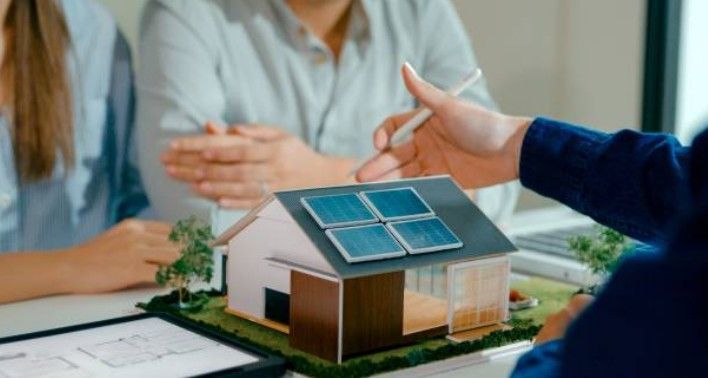Global Community Solar Projects are Setting the Standard – What Canada Needs to Keep Up
Community projects provide a new way for residents,solar contractors, and governments to invest in and use solar power systems. Unlike standard rooftop installations, this gives those without proper roofs or financial resources access to clean electricity.
Key Takeaways:
- A community-driven solar panel installation project enables sustainable electrical access for those without suitable rooftops.
- Sustainable electric projects create jobs and reinvest in group development.
- Canada can accelerate its clean power transition by adopting successful models from countries like Denmark, the U.S., and Australia.
The Global Projects in Various Nations
Many successful projects worldwide are helping to cut greenhouse gas emissions. These projects help homeowners benefit from a shared system. This approach makes sustainable electric sources accessible to those whose homes aren't suitable for panels or who don't own their property.
Some countries that are beginning to create sustainable electric farms include:
Cooperative Energy Futures (CEF) – Minnesota, USA
Cooperative Energy Futures (CEF) is a member-owned cooperative that provides affordable solar energy solutions, particularly to low-income and marginalized communities. Founded in 2009, CEF operates eight sun gardens, generating 6.9 megawatts (MW).
Key Features of CEF’s Model
- Subscription-Based Model: Households subscribe to sun gardens and receive bill credits based on the electricity generated by their portion of the system.
- Affordability: Members enjoy up to 10% annual savings on energy bills.
- Utility Partnerships: Collaborates with Xcel Energy to integrate clean power into the grid and guarantee seamless crediting for subscribers.
- Long-Term Impact: To reduce electricity bills for 700+ households over the next 25 years.
By prioritizing equitable access to clean power, CEF serves as a model for Canada’s electric transition. This particularly addresses affordability and inclusivity concerns.
Samsø Island – Denmark
Denmark’s Samsø Island is a global leader in community-driven renewable output. The island transitioned from fossil fuels to 100% renewable electricity in under a decade, primarily through public-owned wind and sun installations.
Samsø uses large-scale photovoltaic (PV) farms integrated with district heating systems to maximize efficiency. Residents collectively own PV and wind installations to warrant financial benefits and less greenhouse gas emissions. A mix of battery storage and smart grid technologies balances supply and demand.
Brixton Energy Solar – United Kingdom
Based in South London, this is a non-profit cooperative that develops community-owned program to reduce electric costs, combat fuel poverty, and create local jobs. This demonstrates how community-led plans can thrive in dense urban environments, a lesson valuable for Canadian cities like Toronto, Vancouver, and Montreal.
Impact on Residents
| Inner-City Renewable Energy | Inner-City Renewable Energy The UK’s first cooperatively owned project on a social housing estate. |
| Local Economic Benefits | Education and job training opportunities. |
| Initiatives include panel-making workshops, advice sessions, and internships for youth. | Initiatives include panel-making workshops, advice sessions, and internships for youth. |
| Government & Non-Profit Support | Brixton partners with Repowering London and Lambeth Council to expand public initiatives. |
Repower Shoalhaven – Australia
Repower Shoalhaven, launched in 2013 in New South Wales, Australia, is a community-driven initiative that enables businesses, schools, and institutions to transition to clean power. This initiative happens with the help of crowdfunded investments.
What Made It Successful
- Crowdfunded Programs: Investors contribute to solar installations and receive financial returns through power purchase agreements (PPAs).
- Long-Term Sustainability: Reinvested into future plans to create a self-sustaining renewable model.
- Environmental Benefits: Helped over 30 businesses transition. It generates 60,000 kWh of clean output and prevents 3,300+ tonnes of carbon footprint emissions.
- Ownership: More than 100 members and investors participate in the decision-making and operation of programs.
This decentralized investment approach could be an effective model for Canadian small businesses and cooperatives looking to fund their renewable electrical programs.
Hawaii Island Community-Driven Project – USA
Hawaii has set an ambitious target of 100% renewable energy sources by 2045. The Hawaii Island Project aims to make installing solar panel systems accessible to renters, low-income families, and households without suitable rooftops.
This model is particularly relevant for remote and Indigenous communities in Canada, where electric independence and cost reduction are necessary.
Advancing Equity in an Island Grid
- Virtual Net Metering: Subscribers receive bill credits for outputs produced, even without PVs on their property.
- Statewide Renewable Strategy: Aligns with Hawaii’s long-term clean power transition plan.
- Job Creation & Education: Supports workforce training programs to guarantee local economic benefits.
How These Projects Lead the Way for Canada
Sustainability not only benefits the environment. These programs and technologies also create opportunities for local communities and stimulate economic growth.
Collective Installation Expands Access to Renewable Source
Many Canadian households, renters, and businesses lack access to rooftop units due to high costs, structural limitations, or ownership issues. Public modules remove these barriers and allow more people to participate in the transition.
What We Can Do:
- Adopt subscription-based models like CEF and Hawaii’s Virtual Net Metering to allow broader participation.
- Support cooperatives and non-profits in developing public sun gardens in urban and rural areas.
Economic Benefits & Job Creation
These projects generate local employment in construction, maintenance, and management. Models like Brixton Energy and Repower Shoalhaven reinvest revenues into training, internships, and green workforce development.
Canada can prioritize public ownership to certify financial benefits remain local. It can also provide installation training programs to boost employment in Indigenous and remote communities.
Innovative Financing Models Encourage Investment
Canada can attract private investment by implementing bonds (like SolarShare) or crowdfunded solar PV systems (like Repower Shoalhaven). These models provide stable returns while financing new developments.
Actionable Steps
- Expand green investment programs that allow citizens to invest in sustainable projects.
- Implement Power Purchase Agreements (PPAs) to fund units for businesses, schools, and municipalities.
Expand Public Engagement & Education
Programs like Brixton Energy’s training initiatives and Hawaii’s workforce programs strengthen local participation and job creation. Public awareness campaigns can increase buy-in and accelerate the adoption of public initiatives.
Tailor Projects for Rural, Urban & Indigenous Communities
Urban models (e.g., Brixton) demonstrate how group installations can work in dense metropolitan areas.
In the 2021 Canadian Census of Population, over 1.89 million individuals (or 5.0% of the total population) presented themselves as Indigenous. Indigenous communities could benefit from off-grid solutions similar to Hawaii’s equity model.
Role of Solar Contractors
- Project Development and Planning: Identify suitable locations for farms, conduct feasibility studies (technical, economic, and social), and guide complex permitting and regulatory processes. They can also assist in securing funding through grants, loans, or partnerships with non-profit organizations and impact investors.
- Engineering, Procurement, and Construction (EPC): This is the core function. The company designs the farm, procures the necessary equipment (panels, inverters, mounting structures), and oversees the construction.
- Operation and Maintenance (O&M): Handles the ongoing maintenance, including cleaning the panels, monitoring performance, and repairing any issues.
- Training and Capacity Building: Contribute to local economic development by providing training programs for members in installation, maintenance, and related skills. This can create long-term employment opportunities.
- Monitoring and Evaluation: Track the modules and measure their impact, including electric access, cost savings, and environmental benefits.

Making Solar Energy Systems Accessible For All
Community installation offers a scalable, inclusive, and financially sustainable approach to clean electricity adoption in Canada. The global case studies show that with the right policies, financing models, and public engagement, these systems can be accessible to all.
Now is the time for Canada to embrace group systems, strengthen electric independence, and fight climate change. This is where trusted solar panel companies play an essential role. Contact Coquitlam Solar Energy today to explore how we can bring sustainable electricity to your neighbourhood.
Frequently Asked Questions
Can public solar systems integrate with existing electricity grids?
Yes. The grid receives output, and participants receive utility bill credits for their contributions. A reliable solar panel installer and utility companies are generally involved in these installations to monitor the flow and check the distribution of electricity.
Are these installations suitable for colder or cloudy climates?
Yes, these systems can thrive in colder or cloudy climates. While PVs work best in sunny conditions, they can still generate electricity in overcast or cold environments. Modern units are effective at capturing sunlight, even in winter months. Many successful systems operate in regions with low sunlight and still deliver.
Are there collective modules in Canada?
Yes, but not in all provinces. There is one in Ontario. Founded in 2010, SolarShare is a leading Canadian community-owned renewable cooperative. With over 2,000 members, it enables individuals and organizations to invest directly by purchasing SolarBonds, with all investment funds going directly to support these initiatives.
CONTACT
Telephone: 604-337-1958
E-mail: info@coquitlamsolarenergy.ca
LOCATION
Coquitlam, BC V3B 0A4, Canada
Coquitlam Solar Energy | All Rights Reserved | 2023
